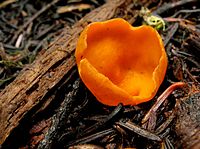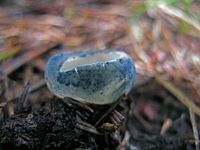- Caloscypha
-
Caloscypha 
Scientific classification Kingdom: Fungi Division: Ascomycota Class: Pezizomycetes Order: Pezizales Family: Caloscyphaceae Genus: Caloscypha Species: C. fulgens Binomial name Caloscypha fulgens
(Pers.) Boud. (1885)Synonyms[1] Peziza fulgens Pers. (1822)
Otidella fulgens (Pers.) Sacc. (1889)
Barlaea fulgens (Pers.) Rehm (1908)
Lamprospora fulgens (Pers.) Snyder (1936)
Geniculodendron pyriforme G.A.Salt (1974)
Pseudoplectania fulgens (Pers.) FuckelCaloscypha fulgens Mycological characteristics 
glebal hymenium 
no distinct cap 
hymenium attachment is not applicable 
lacks a stipe 
spore print is white 
ecology is saprotrophic 
edibility: inedible Caloscypha is a fungal genus in the Caloscyphaceae family (Pezizales order). A monotypic genus, it contains the single species Caloscypha fulgens, commonly known as the spring orange peel fungus, the golden cup, or the dazzling cup. It is a cup fungus, typically up to 4 centimetres (1.6 in) in diameter, with a bright to pale orange interior and orange; specimens that are old or bruised often have an olive-green discoloration, especially around the edges. In North America, it is usually found on the ground in forest litter near conifers. Fruiting occurs in early spring following snow melt. The asexual (imperfect), or conidial stage of C. fulgens is the plant pathogenic species Geniculodendron pyrofirme, known to infect dormant seeds of the Sitka spruce.
Contents
Taxonomy
This species was first described by Christian Hendrik Persoon in 1822 as Peziza fulgens, and has been grouped in several different genera since its original description. Phylogenetic analysis of DNA sequence data shows that within the Pezizales order, Caloscypha fulgens belongs in an evolutionary lineage with the families Helvellaceae, Morchellaceae, and Tuberaceae.[2] Since 1968, Caloscypha had been placed in the Pyronemataceae family, a small grouping of fungi distinguished from other Pezizales by their relatively undeveloped peridium.[3] In 2002, the new family Caloscyphaceae was described to contain the monotypic genus Caloscypha.[4]
The distinctive orange-yellow color of the fungus has earned it the common names "spring orange peel fungus",[5] the "golden cup",[6] and the "dazzling cup".[7] The specific epithet means "bright colored", while the genus name Caloscypha means "beautiful cup".[8]
Description
From Trinity National Forest, CaliforniaThe fruiting body of C. fulgens is roughly cup-shaped, although the cup may be somewhat flattened, lopsided or split; the size is up to 4 centimetres (1.6 in) in diameter. The inner surface of the cup is orange-yellow, while the external surface is pale yellow. Either the margin around the rim or the entire outer surface may be stained olive-green.[5] The green or bluish staining that occurs upon injury or with age is unique within the Pezizales order.[9] The stem, if present, is rather short. The spore deposit is white.[10]
A single specimen of an albino form, 2 centimetres (0.8 in) in diameter, was discovered in Northern Idaho; it was found to be lacking the pigment responsible for staining the outer surface olive-green.[11]
The spores are translucent (hyaline), roughly spherical, thin-walled and smooth, with dimensions of 6–8 µm in diameter.[12] The asci, the spore-bearing cells, are cylindrical and 80–100 by 7–8 µm; the paraphyses are thin and filamentous and contain orange granules.[5] Edibility has not been recorded for this fungus.[10][12]
Habitat and distribution
This species is usually found in the spring, often on duff under conifers shortly after the snow melts. In North America, where it has been noted to occur only between March and July,[13] it is widespread in the Rocky Mountains and the Pacific Northwest.[5] C. fulgens has been collected in Britain, and possibly arrived there from imported infected seeds.[13] It has also been collected from Japan,[14] Sweden,[15] The Netherlands,[16] and Turkey.[17] It is listed on the Red List of protected species in Slovakia.[18]
Imperfect state
The life cycle of this fungus allows for both an imperfect (making asexual spores, or conidia ) or perfect (making sexual spores) form; as has often happened in fungal taxonomy, the imperfect form was given a different name, because the relationship between the perfect and imperfect forms of the same species was not then known. The imperfect, or conidial stage of this fungus is the plant pathogen Geniculodendron pyrofirme, first reported in 1964,[19] and known to infect dormant seeds of the Sitka spruce, Picea sitchensis.[13] A 1978 study showed that about a third of Sitka spruce seed lots stored by the British Columbia Forest Service (Canada) contained diseased seeds, and these diseased seeds failed to germinate when sown in local nurseries.[20] The fungus can grow at low temperatures, contributing to its ability to kill seeds before they have a chance to germinate.[21][22][23] Infected seeds tend to shrivel and dry up rather than rot.[24] It was also demonstrated that seed lots from squirrel seed caches have increased incidence of C. fulgens infection. Squirrels tend to cache pinecones repeatedly in the same location, and in cool, moist conditions favorable for fungus growth.[25] In 2002, G. pyriforme was found on imported conifer seeds in Germany, the first such report in continental Europe.[26]
Similar species
Caloscypha fulgens bears some resemblance to the orange-peel fungus (Aleuria aurantia); however, A. aurantia does not have the characteristic bluing reaction upon bruising or with age, and it fruits later in the season (usually in autumn).[10]
References
- ^ "Species synonymy: Caloscypha fulgens (Pers.) Boud.". Index Fungorum. CAB International. http://www.speciesfungorum.org/Names/SynSpecies.asp?RecordID=120499. Retrieved 2011-06-14.
- ^ Landvik S, Egger KN, Schumacher T. (1997). "Towards a subordinal classification of the Pezizales (Ascomycota): phylogenetic analyses of SSU rDNA sequences". Nordic Journal of Botany 17 (4): 403–18. doi:10.1111/j.1756-1051.1997.tb00337.x.
- ^ Eckblaad F-E. (1968). "The genera of the operculate discomycetes". Nytt Botaniska Notiser 15: 1–191.
- ^ Harmaja J. (2002). "Caloscyphaceae, a new family of the Pezizales". Karstenia 42 (1): 27–28.
- ^ a b c d Tylutki EE. (1979). Mushrooms of Idaho and the Pacific Northwest. Moscow, Idaho: University Press of Idaho. pp. 93–94. ISBN 0-89301-062-6.
- ^ Storey M. "Caloscypha fulgens (Pers.) Boud., 1885 (Golden Cup)". BioImages. http://www.bioimages.org.uk/HTML/T122999.HTM. Retrieved 2009-06-25.
- ^ McKnight VB, McKnight KH. (1987). A Field Guide to Mushrooms, North America. Boston, Massachusetts: Houghton Mifflin. pp. 60–61]. ISBN 0-395-91090-0. http://books.google.com/books?id=kSdA3V7Z9WcC&pg=PA59.
- ^ Weber NS, Smith AH. (1980). The Mushroom Hunter's Field Guide. Ann Arbor, Michigan: University of Michigan Press. pp. 28–29. ISBN 0-472-85610-3.
- ^ Hansen K, Pfister DH. (2006). "Systematics of the Pezizomycetes—the operculate discomycetes". Mycologia 98 (6): 1029–40. doi:10.3852/mycologia.98.6.1029. PMID 17486978. http://www.mycologia.org/cgi/content/full/98/6/1029?ck=nck.
- ^ a b c Wood M, Stevens F. "Caloscypha fulgens". California Fungi. MykoWeb. http://www.mykoweb.com/CAF/species/Caloscypha_fulgens.html. Retrieved 2009-06-25.
- ^ Rogers JD, Bonman JM. (1978). "A white variant of Caloscypha fulgens from Northern Idaho". Mycologia 70 (6): 1286–87. doi:10.2307/3759335. http://jstor.org/stable/3759335.(subscription required)
- ^ a b Orr DB, Orr RT. (1979). Mushrooms of Western North America. Berkeley, California: University of California Press. p. 38. ISBN 0-520-03656-5.
- ^ a b c Paden JW, Sutherland JR, Moods TAD. (1978). "Caloscypha fulgens (Ascomycetidae, Pezizales): the perfect state of the conifer seed pathogen Geniculodendron pyriforme (Deuteromycotina, Hyphomycetes)". Canadian Journal of Botany 56 (19): 2375–79. doi:10.1139/b78-289.
- ^ Nagao H. (2002). "Fungal flora in Chiba Pref., central Japan (III) ascomycetes: Plectomycetes and Discomycetes" (in Japanese). Journal of the Natural History Museum and Institute Chiba Special Issue (5): 111–32.
- ^ Nilsson KG. (1998). "Fungi of Rinkaby and Glanshammar parishes, Narke, C Sweden". Svensk Botanisk Tidskrift 92 (5): 249–70.
- ^ Schmidt N. (1997). "Caloscypha fulgens: second find for The Netherlands" (in Dutch). Coolia 40 (3): 195–96.
- ^ Dogan HH, Ozturk C. (2006). "Macrofungi and their distribution in Karaman province, Turkey" (PDF). Turkish Journal of Botany 30 (3): 193–207. http://journals.tubitak.gov.tr/botany/issues/bot-06-30-3/bot-30-3-5-0506-6.pdf.
- ^ Kautmanova I. (2008). "Redlist species of fungi held in the collections of the Slovak National Museum Natural History museum (bra). iv. Vulnerable species (vu)". Zbornik Slovenskeho Narodneho Muzea Prirodne Vedy 54: 3–28.
- ^ "Diseases & Insects in BC Forest Seedling Nurseries - Seed fungus". Natural Resources Canada: Canadian Forest Service. http://www.pfc.forestry.ca/diseases/nursery/pests/seedfung_e.html. Retrieved 2010-12-29.
- ^ Sutherland JR, Woods, TAD. (1978). "The fungus Geniculodendron pyriforme in stored Sitka spruce seeds: effects of seed extraction and cone collection methods on disease incidence". Phytopathology 68: 747–50. doi:10.1094/Phyto-68-747.
- ^ Epners Z. (1964). "A new psychrophilic fungus causing germination failure of conifer seeds". Canadian Journal of Botany 42 (12): 1589–1604. doi:10.1139/b64-159.
- ^ Salt GA. (1974). "Etiology and morphology of Geniculodendron pyriforme gen. et sp. nov., a pathogen of conifer seeds". Transactions of the British Mycological Society 63 (2): 339–51. doi:10.1016/S0007-1536(74)80179-8.
- ^ Thomson AJ, Sutherland JR, Woods TAD, Moncrieff SM. (1983). "Evaluation of seed disease effects in container-sown Sitka Spruce". Forest Science 29 (1): 59–65.
- ^ Sullivan TP, Sutherland JR, Woods TAD, Sullivan DS. (1983). "Dissemination of the conifer seed fungus Caloscypha fulgens by small mammals". Canadian Journal of Forestry Research 14 (1): 134–37. doi:10.1139/x84-026.
- ^ Sutherland JR. (1979). "Pathogenic fungus Caloscypha fulgens in stored conifer seeds in British Columbia and relation of its incidence to ground and squirrel-cache collected cones". Canadian Journal of Forest Research 9 (1): 129–32. doi:10.1139/x79-024.
- ^ Schroder T, Kehr R, Hutterman A. (2002). "First report of the seed pathogen Geniculodendron pyriforme, the imperfect state of the ascomycete Caloscypha fulgens, on imported conifer seeds in Germany". Forest Pathology 32 (4–5): 225–30. doi:10.1046/j.1439-0329.2002.00288.x.
External links
Categories:- Fungi described in 1822
- Pezizales
- Fungi of Asia
- Fungi of Europe
- Fungi of North America
- Inedible fungi
- Monotypic Ascomycota genera
Wikimedia Foundation. 2010.



